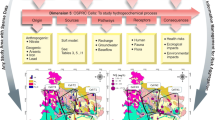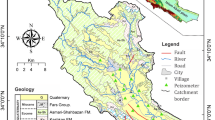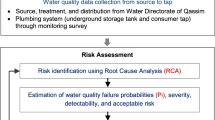Abstract
ICT-based remediation with knowledge information management is presented for the pump-and-treat method of contaminated groundwater. The usefulness of ICT is discussed for monitoring contaminants and groundwater level, transferring data between the remediation well and the remote remediation center, and decision support analysis for controlling the remediation well. A prototype system was developed and applied to field measurement. The prototype system performed reliably for ~600 days. As a decision support analysis, a fuzzy inference model is discussed. The membership functions were determined based on simple reliability theory. The effectiveness of the proposed method was assessed by numerical simulations. The simulation results suggest that the proposed method is likely to reduce the pumped quantity compared to PID control or an engineer’s empirical knowledge. Analysis results are also shown for cancer risks from contaminants and ground settlement risks due to excess pumping up of groundwater.


















Similar content being viewed by others
Abbreviations
- ASTM:
-
American Society for Testing and Materials
- JME:
-
Japan Ministry of Environment
- JMIC:
-
Japan Ministry of Internal Affairs and Communication
- JTA:
-
Japan Tunneling Association
- ICT:
-
Information and communication technologies
- LAN:
-
Local area network
- PID (controller):
-
Proportional integral derivative (controller)
- VOC:
-
Volatile organic compounds
- WHO:
-
World Health Organization
References
Adoko AC, Wu L (2011) Fuzzy inference systems-based approach in geotechnical engineering—a review. Electron J Geotech Eng 16:1543–1558
ASTM E-2081-00 (2000) Standard guide for risk-based corrective action. American Society for Testing and Materials, Washington
Chen C, Pei S, Jiao JJ (2003) Land subsidence caused by groundwater exploitation in Suzhou City. China Hydrogeol J 11:275–287
Hagglund T (1995) PID controllers: theory, design, and tuning, 2 Sub edn. The Instrumentation, Systems, and Automation Society, ISA
Hata T, Miyata Y, Honjo Y (2010) Pumping rate control for contaminated groundwater with VOCs by using fuzzy inference model. Georisk Assess Manag Risk Eng Syst Geohazards 4(2):63–76
JMIC (2007) Technical report on ICT application for secure life. Japan Ministry of Internal Affairs and Communication, Tokyo (in Japanese)
JME (2000) Investigation of groundwater contamination in Japan. Japan Ministry of Environment, Tokyo (in Japanese)
JME (2011) Uniform national effluent standards. Japan Ministry of Environment, Tokyo (in Japanese)
JTA (1985) Design guideline on neighboring construction of structure in underground project. Japan Tunneling Association, Tokyo (in Japanese)
Mamudani EA (1974) Application of fuzzy algorithms for control of a simple dynamic plant. In: Proceeding of IEEE, 121–12, pp 1584–1588
Murakami S, Yasuhara K, Suzuki K, Komine H (2006) Reliable land subsidence mapping using a spatial interpolation procedure based on geostatistics. Soils Found 46(2):123–134
Newell CJ, Rifai HS Wilson JT, Connor JA, Aziz JA, Suarez MP (2002) Calculation and use of first-order rate constants for monitored natural attenuation studies. Environmental Protection Agency ground water issue paper. EPA/540/S-02/500, pp 1–27
Pacheco M, Sivakugan N, Barbosa MC (2009) Statistical assessment of unidirectional propagation of a leachate contamination plume. Geotech Geol Eng 27:123–135
Ross TJ (2010) Fuzzy logic with engineering applications, 3rd edn. Wiley, New York
Tan KK, Wang QG, Hang CC (1999) Advances in PID control. Springer, New York
Terzaghi K, Peck RB, Mesri G (1996) Soil mechanics in engineering practice, 3rd edn. Wiley, New York
WHO (2001) Water quality: guidelines, standards and health. World Health Organization. IWA Publishing
Williams JD (1946) An approximation to probability integral. Ann Math Stat 17:363–365
Wu JC, Shi XQ, Ye SJ, Xue YQ, Zhang Y, Yu J (2005) Land subsidence in China. Environ Geol 57(6):1409–1421
Zadeh LA (1968) Fuzzy algorithms. Inf Control 12:94–102
Zadeh LA (1973) Outline of a new approach to the analysis of complex systems and decision processed. IEEE Trans Syst Man Cybern SMC-3(1):28–44
Ziegler JG, Nichols NB (1942) Optimum settings for automatic controllers. Trans ASME 64:759–768
Author information
Authors and Affiliations
Corresponding author
Rights and permissions
About this article
Cite this article
Miyata, Y., Hata, T. ICT-Based Remediation with Knowledge Information Management for Contaminated Groundwater. Geotech Geol Eng 31, 911–926 (2013). https://doi.org/10.1007/s10706-012-9554-x
Received:
Accepted:
Published:
Issue Date:
DOI: https://doi.org/10.1007/s10706-012-9554-x




